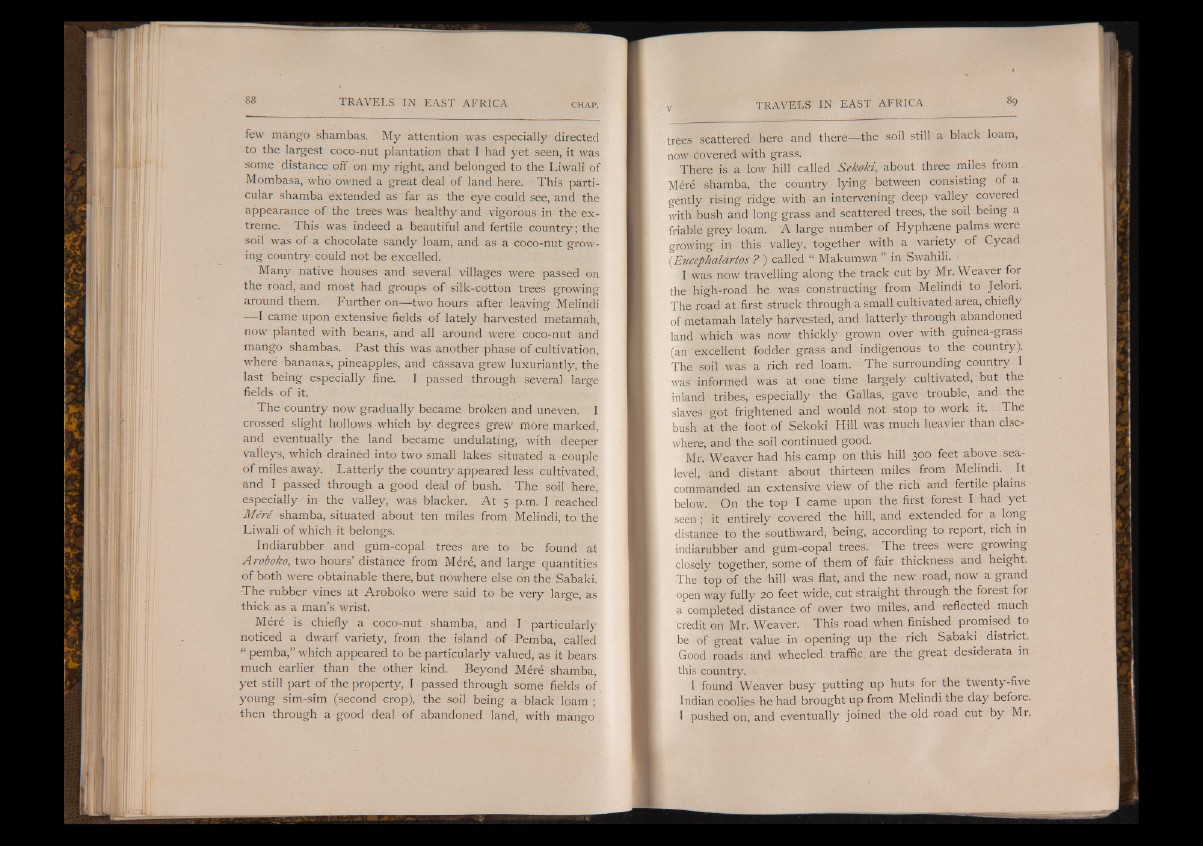
fgw mango shambas. My attention was especially directed
to the largest coco-nut plantation that I had yet seen, it was
some distance off on my right, and belonged to the Liwali of
Mombasa, who owned a great deal of land here. This particular
shamba extended as far as the eye could see, and the
appearance of the trees Was healthy and vigorous in the extreme.
This: was indeed a beautiful and fertile country; the
soil was of a chocolate sandy loam, and as a coco-nut growing
country could not be excelled.
Many native houses and several villages were passed on
the road, and most had groups of silk-cotton trees growing
around them. Further on— two hours after leaving Melindi
I- came upon extensive fields of lately harvested metamah,
now planted with beans, and all around were coco-nut and
mango shambas. Past this, was another phase of cultivation,
where bananas, pineapples, and cassava grew luxuriantly, the
last being especially fine. I passed through several large
fields of it.
The country now gradually became broken and uneven. I
crossed slight hollows which by degrees grew more marked,
and eventually the land became undulating, with deeper
valleys, which drained into two small lakes situated a couple
of miles away. Latterly the country appeared Jess cultivated,
and I passed through a good deal of bush. The soil here,
especially in the valley, was blacker. A t 5 p.m. I reached
Mere shamba, situated about ten miles from Melindi, to the
Liwali of which it belongs.
Indiarubber and gum-copal trees are to , be found at
Aroboko, two hours’ distance from Mere, and large quantities
of both were obtainable there, but nowhere else on the Sabaki.
•The rubber vines at Aroboko were said to be very large, as
thick, as a man’s wrist.
M^re is chiefly a coco-nut shamba, and I particularly
noticed a dwarf variety, from the island of Pemba, called
Apemba,” which appeared to be particularly valued, as it bears
much earlier than the other kind. Beyond M6re shamba,
yet still part of the property, I passed through some fields of
young sim-sim (second crop), the soil being a black loam ;
then through a good deal o f abandoned land, with mango
trees scattered here and there— the soil still a black loam,
now Covered with grass.
There is a low hill called Sekoki, about three miles from
M6re shamba, the country lying between consisting of a
gehtly rising ridge with an intervening deep valley covered
with bush and long grass and scattered trees, the soil being a
friable grey loam. A large number of Hyphaene palms were
growing in this valley, together with a variety of Cycad
{Eucephalartos ? ) called “ Makumwa ” in Swahili.
I was now travelling along the track cut by Mr. Weaver for
the high-road he was constructing from Melindi to Jelori.
The road at first struck through a small cultivated area, chiefly
of metamah lately harvested, and latterly through abandoned
land which was now thickly grown over with guinea-grass
(an excellent fodder grass and indigenous to the country).
The soil was a rich red loam. The surrounding country I
was informed was at one time largely cultivated, but the
inland tribes, especially the Gallas, gave trouble, and the
slaves got frightened and would not stop to work it. The
bush at the foot of Sekoki Hill was much heavier than elsewhere,
and the soil continued good.
Mr. Weaver had his camp on this hill 300 feet above , sea-
level, and distant about thirteen miles from Melindi. It
commanded an extensive view of the rich and fertile plains
below. On the top Icam e upon the first forest I had y et
seen; it entirely covered the hill, and extended for a long
distance to the southward, being, according to report, rich in
indiarubber and gum-copal trees. The trees were growing
closely together, some of them of fair thickness and height.
The top of the hill was flat, and the new road, now a grand
open way fully 20 feet wide, cut straight through the forest for
a completed distance of over two miles, and reflected much
credit on Mr.. Weaver. This road when finished promised to
be of great value, in opening up the rich Sabaki district.
Good roads and wheeled traffic, are the great desiderata in
this country.
I found Weaver busy putting up huts for the twenty-five
Indian coolies he had brought up from Melindi the day before.
1 pushed on, and eventually joined the old road cut by Mr.